

The early glory of nocturnes flourished in the Baroque style known as temebrism (tenebroso in Italian).
Visual art would seem to be most concerned with realms of light. The nocturne proclaims the values of looking at greatly diminished light. It examines darkness, and conditions near its edge.
Examples:

Gerrit van Honthorst (Dutch, 1590-1656), The Denial of Saint Peter, c. 1620, oil on canvas, Minneapolis Institute of Arts. See Dutch art.

Georges De La Tour (French, 1593-1652), Magdalen with the Smoking Flame, c. 1640, oil on canvas, 46 x 36 1/8 inches (116.8 x 91.8 cm), Los Angeles County Museum of Art. See Baroque and French art.

Valentin de Boulogne (French, 1594-1632), A Musical Party, c. 1626, oil on canvas, 44 x 57 3/4 inches (111.76 x 146.69 cm), Los Angeles County Museum of Art.

Rembrandt Harmensz. van Rijn (Dutch, 1606-1669), The Raising of Lazarus, c. 1630, oil on panel, 37 7/8 x 32 inches (96.2 x 81.3 cm), Los Angeles County Museum of Art. See Baroque.

Rembrandt Harmensz. van Rijn, Self-Portrait, 1658, oil on canvas, 52 5/8 x 40 7/8 inches (133.7 x 103.8 cm), Frick Collection, NY. See self-portrait.

Pierre-Jacques Volaire (French, 1727-before 1802), The Eruption of Mt. Vesuvius, 1777, oil on canvas, 53 1/8 x 89 inches (135.0 x 226.1 cm), North Carolina Art Museum, Raleigh. See French art.

Utagawa Toyoharu (Japanese, 1733-1814),
Nakano-chō Street in the Shin Yoshiwara Entertainment Quarter, 18th-19th century,
color woodblock print, image: 9 7/8 x 14 3/4 inches (25.0 x 37.4 cm); sheet: 9 7/8 x 14 3/4 inches (25 x 37.4 cm), Los Angeles County Museum of Art. See Japanese art.

Joseph Wright of Derby (English, 1734-1797),
The Iron Forge Viewed from without, oil on canvas,
105 x 140 cm, Hermitage
Museum, St. Petersburg, Russia. See English art.

Joseph Wright of Derby, A Cottage on Fire, c. 1787, oil
on canvas, 22 7/8 x 30
inches, Minneapolis Institute
of Arts.

Francisco Goya y Lucientes (Spanish, 1746-1828), A Bad Night, 1799,
etching and burnished aquatint; plate: 8 1/2 x 5 15/16 innhes (21.59 x 15.08 cm)
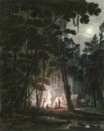
John Hill (American engraver, 1770-1850), View by Moonlight, Near Fayetteville, after a painting by Joshua Shaw (American, 1776-1860), published in Picturesque Views of American Scenery by M. Carey & Son, 1820, hand-colored engraving, New York Public Library. Several figures stand around a campfire in a forest. It is unclear whether this is near Fayetteville, Arkansas or Fayetteville, North Carolina. See picturesque.
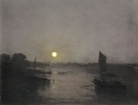
Joseph Mallord William Turner (English, 1775-1851), Moonlight, a Study at Millbank, 1797, oil on canvas, Tate Museum, London. See English art and Romanticism.
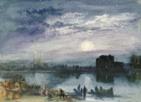
Joseph Mallord William Turner, Saint Denis, c. 1833, oil on canvas, Tate Museum, London. No painter is more reknowned than Turner for his painting of atmosphere and light. In the foreground, a number of people busy themselves on the shore of the Seine, the church of St. Denis in the background to the left. All of this industrious activity might suggest that the central source of light is the sun behind a screen of clouds. However, it is more plausible that we see the moon illuminating this tableau. A number of starry dots and passages of clear sky are painted a very dark violet, rendering it somewhat similar to the sky behind this text.
Fitz Hugh Lane (American, 1804-1865), Ship Starlight, c. 1860, oil on canvas, 30 x 50 inches (76.2 x 127.0 cm), Butler Institute of American Art, Youngstown, OH. See Luminism.
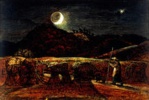
Samuel Palmer (English, 1805-1881), A Cornfield by Moonlight with the Evening Star, c. 1830, watercolor with body color and pen and ink, British Museum, London. See Romanticism.
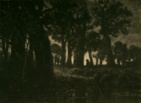
Charles Emile Jacque (French, 1813-1894), Lisière de forêt, effet de soir, no date, etching, New York Public Library.
Jean-François Millet (French, 1814-1875), Fisherman, black crayon, 0.328 x 0.492 m, Louvre. Millet is most associated with the Barbizon school of painters, though he is an important precursor to Realism.

William Trost Richards (American, 1833-1905),
Moonlight on Mount Lafayette, New Hampshire,
1873, watercolor,
gouache, and graphite on gray-green wove paper, 8 1/2 x 14 3/16
inches (21.6 x 36 cm), Metropolitan Museum of Art, NY. See luminosity.

James Abbott McNeil Whistler (American, 1834-1903), Nocturne: Grey and Gold -- Westminster Bridge, 1871-2, Burrell Collection, Glasgow.
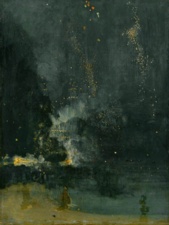
James Abbott McNeil Whistler,
Nocturne in Black and Gold: The Falling Rocket,
c. 1874, oil on canvas,
23 3/4 x 18 3/8 inches, Detroit Institute of Arts. Whistler's
nocturnes were tangible demonstrations of his creed of aestheticism,
which stressed the artist's duty to orchestrate selected elements
from nature into
a composition
that, like music, existed
for its own sake, without regard to moral or didactic
issues. This controversial
viewpoint led to a lawsuit with John Ruskin (1810-1900, English writer,
critic, and artist). Whistler accused Ruskin of slander, when the critic published his opinion of Nocturne in
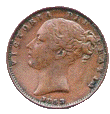 Black and Gold: The Falling Rocket. Ruskin had written,"I have seen, and heard, much of cockney impudence before now; but never expected to hear a coxcomb ask two hundred guineas for flinging a pot of paint in the public's face." Whistler won the libel suit and the fine
of one
Black and Gold: The Falling Rocket. Ruskin had written,"I have seen, and heard, much of cockney impudence before now; but never expected to hear a coxcomb ask two hundred guineas for flinging a pot of paint in the public's face." Whistler won the libel suit and the fine
of one farthing (the English coin of least worth), and yet the affair bankrupted him. Whistler was assured, nevertheless, of a distinguished place as a precursor to abstract art. Also see
art for art's sake, fin de siècle, numismatics, and
pyrotechnics.

James Abbott McNeil Whistler, Nocturne: The Thames at Battersea, 1878,
lithograph,
6 3/4 x 10 1/8 inches (17.1 x 25.7 cm), Metropolitan Museum of
Art, NY. In his Ten O'Clock Lecture, Whistler analyzed
his fascination for the Thames at night, explaining how the evening
mist invested the riverside with poetry, transforming chimneys
into campanili and warehouses
into vast palaces of the night.

James Abbott McNeill Whistler, Nocturne,
1879-80, etching
and drypoint,
7 13/16 x 11 9/16 inches (19.9 x 29.5 cm), Cincinnati Art Museum,
OH.

Atkinson Grimshaw (English, 1836-1893),
Liverpool Quay by Moonlight, 1887, oil on canvas,
61.0 x 91.4 cm, Tate Gallery, London.

Attributed to Ralph Albert Blakelock (American,
1847-1919), Untitled (Moonlight Landscape), n.d.,
oil on panel,
18 x 24 inches, Minneapolis Institute of Arts.
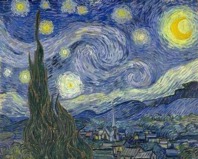
Vincent van Gogh (Dutch, 1853-1890), The Starry Night, June 1889 (Saint Rémy), oil on canvas,
29 x 36 1/4 inches (72 x 92 cm), Museum of Modern Art, NY,
F 612. Van Gogh painted several nocturnes, and wrote, “I often think that the night is more alive and more richly colored than the day.” See expression
and Post-Impressionism.
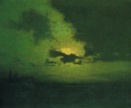
Lovell Birge Harrison (American, 1854-1929), The Hidden Moon, no date, oil on canvas, 25 1/4 x 30 1/8 inches, National Academy of Design, NY.

Henri-Edmond Cross (French, 1856-1910), Landscape with Stars, watercolor over pencil on paper, 9 5/8 x 12 5/8 inches (20.5 x 32.5 cm), Metropolitan Museum of Art, NY. See Neo-Impressionism.

Joseph Pennell (American, 1857-1926),
Blue Night, London, c. 1894-1909, watercolor on light blue paper, 10 x 13 13/16 inches; 25.4 x 35.08 cm, Los Angeles County Museum of Art.

Childe Hassam (American, 1859-1935), Nocturne,
Railway Crossing, Chicago, 1893, watercolor on paper,
16 x 11 3/4 inches (40.6 x 29.8 cm), Museum of Fine Arts, Boston.
Hassam layered subtly varied blue washes
to evoke pavement, skyscrapers, streetcars, and horse-drawn carriages
and added highlights to
capture glowing lights and their
reflections on the wet
street. See American
Impressionism and Ten American
Painters.

Georges-Pierre Seurat (French, 1859-1891),
Circus Sideshow (La Parade), 1887-88,
oil on canvas,
39 1/4 x 59 inches (99.7 x 149.9 cm), Metropolitan Museum of
Art, NY. (On the Met's page, you can enlarge any detail.) This
painting depicts the effects of gas lights illuminating the free
entertainment offered at the entrance of a traveling theater.
This "sideshow" was intended to attract a crowd and
encourage the sale of tickets. See neo-impressionism
and pointillism.
Frederic Remington (American, 1861-1909), Coming to the Call, c. 1905, oil on canvas, William I. Koch collection, Palm Beach, FL. See illustration and wood engraving. Read Joseph Phelan's article about Remington's nocturnes at Artcyclopedia.
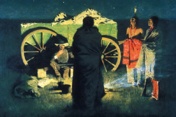
Frederic Remington (American, 1861-1909), Shotgun Hospitality, 1908, oil on canvas, Hood Museum of Art, Dartmouth College, NH. See genre.

Arthur Bowen Davies (American, 1862-1928),
Night's Overture, 1907, oil
on canvas, 18 x 30 1/4
inches, Minneapolis Institute of Arts. See The Eight.
Georges Rouault (French, 1871-1958), Nocturne chrétien (Christian Night), 1952, oil on canvas, 97 x 65.2 cm, Centre Georges Pompidou, Paris. See expression and Expressionism.

Rinaldo Cuneo (American, 1877-1939), The Embarcadero at Night, c. 1927-1928, oil on plywood, 34 x 36 inches (86.4 x 91.4 cm), Los Angeles County Museum of Art.

Augusto Giacometti (Swiss, 1877-1947), Summer Night, 1917, oil on canvas, 26 1/2 x 25 5/8 inches (67.2 x 65 cm), Museum of Modern Art, NY.
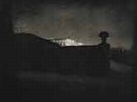
Edward Steichen (American, born Luxembourg, 1879-1973), Nocturne-Orangerie, 1910, printed 1913, photogravure, 6 5/16 x 8 1/4 inches (16.03 x 20.96 cm), Los Angeles County Museum of Art. See photography.
Pablo Picasso, Night Fishing at Antibes, Antibes, August 1939, oil on canvas, 6 feet 9 inches x 11 feet 4 inches (205.8 x 345.4 cm).
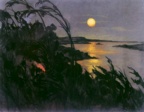
Stanislaw Ignacy (Witkacy) Witkiewicz (Polish,
1885-1939), Moonrise Australia, 1918, pastel and crayon
on cardboard, 51.5 x
65.5 cm, Museum of Literature, Warsaw. See Polish
art.

Karl Struss (American, 1886-1981),
Brooklyn Bridge, Nocturne, c. 1913, printed 1979,
platinum print photograph, 3 5/8 x 4 1/2 inches (9.21 x 11.43 cm), Los Angeles County Museum of Art.
Georgia O'Keeffe (American, 1887-1986), Train at Night in the Desert, 1916, watercolor and pencil on paper, 11 7/8 x 8 7/8 inches (30.3 x 22.5 cm), Museum of Modern Art, NY.
Georgia O'Keeffe, Evening Star, III, 1917, watercolor on paper, 8 7/8 x 11 7/8 inches (22.7 x 30.4 cm), Museum of Modern Art, NY.

Charles E. Burchfield (American, 1893-1967),
Moon
through Young Sunflowers, 1916, gouache, graphite,
and watercolor
on paper,
Carnegie Museum of Art, Pittsburgh, PA.
Joan Miró (Spanish, 1893-1983), The Beautiful Bird Revealing the Unknown to a Pair of Lovers from the "Constellation series," July 23, 1941, gouache, oil wash, and charcoal on paper, 18 x 15 inches (45.7 x 38.1 cm), Museum of Modern Art, NY.

Itō Shinsui (Japanese, 1898-1972), Night Rain at Tago Beach, 1939,
color woodblock print, image: 9 5/16 x 14 13/16 inches (24.7 x 37.6 cm); paper: 10 11/16 x 15 1/2 inches (27.2 x 39.3 cm), Los Angeles County Museum of Art.
Willem de Kooning (American, born in The
Netherlands, 1904-1997), Night, 1948, oil
on canvas, 23 x 28 inches,
Minneapolis Institute of Arts. See Abstract Expressionism.

Brad Cole (American, 1957-)
New Moon, Evening Star, Ocean, 1989, gelatin-silver print photograph, 17 x 23 5/8 inches (43.18 x 60.01 cm), Los Angeles County Museum of Art.
NASA (USA's space agency), composite photograph of the entire earth at night, showing lights visible from space, . This is a very large image at 2400 x 1200 pixels.
![]()

Also see Caravaggisti, dark, day for night, light, night blindness or nyctalopia, pearlescent, pyrotechnics, and tenebroso or tenebrism.
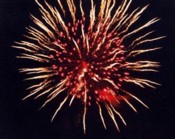
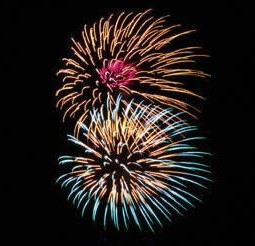
https://inform.quest/_art
![]() Copyright
© 1996-
Copyright
© 1996-![]()
![]()
![]()